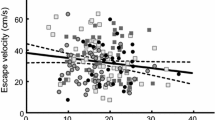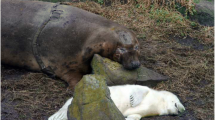Abstract
Pregnancy is associated with reduced locomotor performance in many types of animals, but we do not know to what degree this correlation is caused by simple physical burdening, versus physiological changes associated with pregnancy, or to confounding variables (such as season or female body size) that simultaneously influence both reproductive investment and locomotor speeds. To identify causal effects of burden on locomotion, we need to experimentally manipulate the size of the load being carried. Injection of sterile fluid into the peritoneal cavities of 84 garden skinks (Lampropholis guichenoti) showed that speeds decreased with increasing burdens. Lizards with a burden equivalent to 25% of their body mass ran about 15% slower, mirroring the situation seen in gravid lizards of this population. Thus, simple physical burdening appears to be the primary causal component of the locomotor cost of reproduction within these animals. A lizard's sex, body size and shape had little effect on its running ability either before or after treatment, but faster lizards showed a greater performance decrement after burdening than did their slower conspecifics.


Similar content being viewed by others
References
Atchley WR, Gaskins CT, Anderson D (1976) Statistical properties of ratios. I. Empirical results. Syst Zool 25:137–148
Bell G (1980) The costs of reproduction and their consequences. Am Nat 116:45–76
Berglund A, Rosenqvist G (1986) Reproductive costs in the prawn Palaemon adspesus: effects on growth and predator vulnerability. Oikos 46:349–354
Brodie EDI, Brodie ED Jr (1999) Costs of exploiting poisonous prey: evolutionary trade-offs in a predator-prey arms race. Evolution 53:626–631
Bull JJ, Shine R (1979) Iteroparous animals that skip opportunities for reproduction. Am Nat 114:296–316
Cogger HG (2000) Reptiles and amphibians of Australia, 6th edn. Reed New Holland, Sydney
Cooper WE Jr, Vitt LJ, Hedges R, Huey RB (1990) Locomotor impairment and defense in gravid lizards (Eumeces laticeps): behavioural shift in activity may offset costs of reproduction in an active forager. Behav Ecol Sociobiol 27:153–157
Diddle AW (1984) Interrelationship of pregnancy and athletic performance. J Tenn Med Assoc 77:265–269
Downes SJ, Shine R (2001) Why does tail loss increase a lizard's later vulnerability to snake predators? Ecology 82:1293–1303
Foley N (1998) The mommy track. Women's Sports Fitness 20:48–51
Gans C (1974) Biomechanics: an approach to vertebrate biology. Lippincott, Philadelphia
Greer AE (1989) The biology and evolution of Australian lizards. Surrey Beatty, Australia
Gu H, Danthanarayana W (2000) Variations in life history traits and flight capacity among populations of the light brown apple moth Epiphyas postvittana (Walker) (Lepidoptera: Tortricidae). Aust Ecol 25:571–579
Isaacs R, Byrne D (1998) Aerial distribution, flight behaviour and eggload: their inter- relationship during dispersal by the sweet potato whitefly. J Anim Ecol 67:741–750
Joss JMP, Minard JA (1985) On the reproductive cycles of Lampropholis guichenoti and L. delicata (Squamata: Scincidae) in the Sydney region. Aust J Zool 33:699–704
Lee SJ, Witter MS, Cuthill IC, Goldsmith AR (1996) Reduction in escape performance as a cost of reproduction in gravid starlings, Sturnus vulgaris. Proc R Soc Lond Ser B 263:619–623
Magnhagen C (1990) Reproduction under predation risk in the sand goby, Pomatoschistus minutus, and the black goby, Gobius niger: the effect of age and longevity. Behav Ecol Sociobiol 26:331–335
Magnhagen C (1991) Predation risk as a cost of reproduction. Trends Ecol Evol 6:183–186
McLean J, Speakman J (2000) Morphological changes during postnatal growth and reproduction in the brown long-eared bat Plecotus auritus: implications for wing loading and predicted flight performance. J Nat Hist 34:773–791
Miles DB, Sinervo B, Frankino WA (2000) Reproductive burden, locomotor performance, and the cost of reproduction in free ranging lizards. Evolution 54:1386–1395
Noordwijk AJ van, de Jong G (1986) Acquisition and allocation of resources: their influence on variation in life-history tactics. Am Nat 128:137–142
Olsson M, Shine R, Bak-Olsson E (2000) Locomotor impairment of gravid lizards: is the burden physical or physiological? J Evol Biol 13:263–268
Pengilley R (1972) Systematic relationships and ecology of some lygosomine lizards from southeastern Australia. PhD dissertation, Australian National University, Canberra
Potteiger JA, Welch JC, Byrne JC (1993) From parturition to marathon: a 16-wk study of an elite runner. Med Sci Sports Exerc 25:673–677
Qualls CP, Shine R (1998) Costs of reproduction in conspecific oviparous and viviparous lizards, Lerista bougainvillii. Oikos 82:539–551
Qualls FJ (1996) Sources of phenotypic variation in an Australian skink, Lampropholis guichenoti. PhD dissertation, University of Sydney
Qualls FJ, Shine R (1997) Geographic variation in "costs of reproduction" in the scincid lizard Lampropholis guichenoti. Funct Ecol 11:757–763
Roff DA (1992) The evolution of life histories. Chapman and Hall, New York
Schaffer WM (1974) Optimal reproductive effort in fluctuating environments. Am Nat 108:783–900
Schwarzkopf L (1996) Decreased food intake in lizards: a fecundity dependent cost of reproduction. Aust J Ecol 21:355–362
Schwarzkopf L, Shine R (1992) Costs of reproduction in lizards: escape tactics and vulnerability to predation. Behav Ecol Sociobiol 31:1725
Seigel RA, Huggins MM, Ford NB (1987) Reduction in locomotor ability as a cost of reproduction in snakes. Oecologia 73:481–465
Shaffer L, Formanowicz D (1996) A cost of viviparity and parental care in scorpions: reduced sprint speed and behavioural compensation. Anim Behav 51:1017–1023
Shine R (1980) "Costs" of reproduction in reptiles. Oecologia 46:92–100
Shine R (1992) Relative clutch mass and body shape in lizards and snakes: is reproductive investment constrained or optimized? Evolution 46:828–833
Sinervo B, DeNardo DF (1996) Costs of reproduction in the wild: path analysis of natural selection and experimental tests of causation. Evolution 50:1299–1313
Sinervo B, Hedges R, Adolph SC (1991) Decreased sprint speed as a cost of reproduction in the lizard Sceloporus occidentalis—variation among populations. J Exp Biol 155:323–336
Swan G (1990) A field guide to the snakes and lizards of New South Wales. Three Sisters, Winmalee
Veasey J, Houston D, Metcalfe N (2000) Flight muscle atrophy and predation risk in breeding birds. Funct Ecol 14:115–121
Veasey J, Houston D, Metcalfe N (2001) A hidden cost of reproduction: the trade-off between clutch size and escape take-off speed in female zebra finches. J Anim Ecol 70:20–24
Vitt LJ, Congdon JD (1978) Body shape, reproductive effort, and relative clutch mass in lizards: resolution of a paradox. Am Nat 112:595–608
Williams GC (1966a) Adaptation and natural selection. Princeton University Press, Princeton, N.J.
Williams GC (1966b) Natural selection, the costs of reproduction, and a refinement of Lack's principle. Am Nat 100:687–690
Winfield IJ, Townsend CR (1983) The cost of copepod reproduction: increased susceptibility to fish predation. Oecologia 60:406–411
Acknowledgements
I thank Melanie Elphick and George Barrott-Brown for their enthusiastic and highly skilled assistance in all aspects of this study. The work was funded by the Australian Research Council.
Author information
Authors and Affiliations
Corresponding author
Rights and permissions
About this article
Cite this article
Shine, R. Effects of pregnancy on locomotor performance: an experimental study on lizards. Oecologia 136, 450–456 (2003). https://doi.org/10.1007/s00442-003-1281-9
Received:
Accepted:
Published:
Issue Date:
DOI: https://doi.org/10.1007/s00442-003-1281-9




